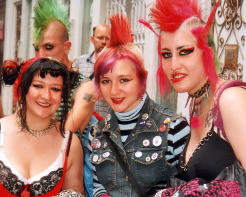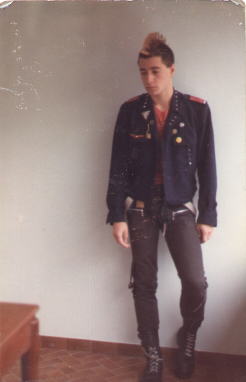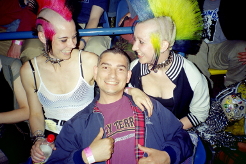| |  The punk subculture is centered around listening to recordings or live concerts of a loud, aggressive genre of rock music called punk rock, usually shortened to punk. While most punk rock uses the distorted guitars and noisy drumming that is derived from 1960s garage rock and 1970s pub rock, some punk bands incorporate elements from other subgenres, such as metal (e.g., mid-1980s-era Discharge) or folk rock (Billy Bragg). Different punk subcultures often distinguish themselves by having a unique style of punk rock, although not every style of punk rock has its own associated subculture. Most punk rock songs are short, have simple and somewhat basic arrangements using relatively few chords, and they use lyrics that express punk values and ideologies ranging from the nihilism of the Sex Pistols' "No Future" to the positive, anti-drug message of Minor Threat's "Straight Edge". Punk rock is usually played in small bands rather than by solo artists. Punk bands usually consist of a singer, one or two overdriven electric guitars, an electric bass player, and a drummer (the singer may be one of the musicians). In some bands, the band members may do backup vocals, but these typically consist of shouted slogans, choruses, or football(soccer)-style chants, rather than the sweet, arranged harmony vocals of pop bands The punk subculture is centered around listening to recordings or live concerts of a loud, aggressive genre of rock music called punk rock, usually shortened to punk. While most punk rock uses the distorted guitars and noisy drumming that is derived from 1960s garage rock and 1970s pub rock, some punk bands incorporate elements from other subgenres, such as metal (e.g., mid-1980s-era Discharge) or folk rock (Billy Bragg). Different punk subcultures often distinguish themselves by having a unique style of punk rock, although not every style of punk rock has its own associated subculture. Most punk rock songs are short, have simple and somewhat basic arrangements using relatively few chords, and they use lyrics that express punk values and ideologies ranging from the nihilism of the Sex Pistols' "No Future" to the positive, anti-drug message of Minor Threat's "Straight Edge". Punk rock is usually played in small bands rather than by solo artists. Punk bands usually consist of a singer, one or two overdriven electric guitars, an electric bass player, and a drummer (the singer may be one of the musicians). In some bands, the band members may do backup vocals, but these typically consist of shouted slogans, choruses, or football(soccer)-style chants, rather than the sweet, arranged harmony vocals of pop bands
• History
 The punk subculture is a youth movement based around punk rock. Punk first emerged from the rock music scene in the United States and the United Kingdom in the mid-1970s. Since then, the punk movement has spread around the world and developed into a number of different forms with much regional variation. Punk culture encompasses certain styles of music, ideology, fashion, visual art, dance, literature, and film. Punks tend to live a certain lifestyle and share a sense of community with one another. The punk subculture is a youth movement based around punk rock. Punk first emerged from the rock music scene in the United States and the United Kingdom in the mid-1970s. Since then, the punk movement has spread around the world and developed into a number of different forms with much regional variation. Punk culture encompasses certain styles of music, ideology, fashion, visual art, dance, literature, and film. Punks tend to live a certain lifestyle and share a sense of community with one another.
The punk scene is composed of an assortment of smaller subcultures, such as Oi! and hardcore punk. These subcultures distinguish themselves from one another through unique variations on punk culture. Several of these factions have developed out of punk to become youth movements in their own right, including straight edge, goth and psychobilly. Punk has had a tumultuous relationship with both popular culture and other subcultures.
• Ideologies
 Punk politics cover the entire political spectrum, although most punks could be categorized as having left-wing or progressive views. Punk-related ideologies are mostly concerned with individual freedom and anti-establishment views. Common punk viewpoints include anti-authoritarianism, a DIY ethic, non-conformity, direct action and not selling out. Other notable trends in punk politics include nihilism, anarchism, socialism, anti-militarism, anti-capitalism, anti-racism, anti-sexism, anti-nationalism, anti-homophobia, environmentalism, vegetarianism, veganism and animal rights. However, some individuals within the punk subculture hold right-wing views (such as those associated with the Conservative Punk website), neo-Nazi views (Nazi punk), or are apolitical (e.g.horror punk). Punk politics cover the entire political spectrum, although most punks could be categorized as having left-wing or progressive views. Punk-related ideologies are mostly concerned with individual freedom and anti-establishment views. Common punk viewpoints include anti-authoritarianism, a DIY ethic, non-conformity, direct action and not selling out. Other notable trends in punk politics include nihilism, anarchism, socialism, anti-militarism, anti-capitalism, anti-racism, anti-sexism, anti-nationalism, anti-homophobia, environmentalism, vegetarianism, veganism and animal rights. However, some individuals within the punk subculture hold right-wing views (such as those associated with the Conservative Punk website), neo-Nazi views (Nazi punk), or are apolitical (e.g.horror punk).
Early British punks expressed nihilistic views with the slogan No Future, which came from the Sex Pistols song "God Save the Queen". In the United States, punks had a different approach to nihilism based on their "unconcern for the present" and their "disaffection from both middle and working class standards".[citation needed] Punk nihilism was expressed in the use of "harder, more self-destructive, consciousness-obliterating substances like heroin, or ... methamphetamine" and by the "mutilation of the body" with razor blades.
| |



